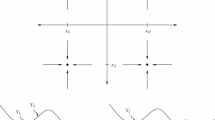Abstract
We discuss the simulation ofM replications of a uniformizable Markov chain simultaneously and in parallel (the so-called parallel replicated approach). Distributed implementation on a number of processors and parallel SIMD implementation on massively parallel computers are described. We investigate various ways of inducing correlation across replications in order to reduce the variance of estimators obtained from theM replications. In particular, we consider the adaptation of Stratified Sampling, Latin Hypercube Sampling, and Rotation Sampling to our setting. These algorithms can be used in conjunction with the Standard Clock simulation of uniformized chains at distinct parameter values and can potentially sharpen multiple comparisons of systems in that setting. Our investigation is primarily motivated by this consideration.
Similar content being viewed by others
References
Avramidis, A. 1992. Variance reduction for quantile estimation via correlation induction.Proceedings of the Winter Simulation Conference, 572–576.
Barnhart, C. M., Wieselthier, J. E., and Ephermides, A. 1993. Improvement in simulation efficiency by means of the standard clock: A quantitative study.Proceedings of the IEEE Conference on Decision and Control, 2217–2223.
Bratley, P. B., Fox, B. L., and Schrage, L. E. 1987.A Guide to Simulation. 2d ed., New York: Springer-Verlag.
Cassandras, C. G., and Strickland, S. G. 1989. On-line sensitivity analysis of markov chains.IEEE Trans. on Automatic Control 34: 76–86.
Cassandras, C. G., and Strickland, S. G. 1989. Observable augmented systems for sensitivity analysis of Markov and semi-Markov processes.IEEE Trans. on Automatic Control 34: 1026–1037.
Cassandras, C. G. 1994. Sample-path-based continuous and discrete optimization of discrete event systems: From gradient estimation to “Rapid Learning.”Proceedings of the 11th International Conference on Analysis and Optimization of Systems.
Chen, C. H., and Ho, Y. C. 1995. An approximation approach of the standard clock method for general discrete event simulation.IEEE Trans. on Control Systems Technology 3(3): 309.
Cheng, R. C. H., Davenport, T. 1989. The problem of dimensionality in stratified sampling.Management Science 35: 1278–1296.
Fishman, G. S. 1983a. Accelerated accuracy in the simulation of Markov chains.Oper. Res. 31: 466–487.
Fishman, G. S. 1983b. Accelerated convergence in the simulation of countably infinite state Markov chains.Oper. Res. 31: 1074–1089.
Fishman, G. S., Huang, B. D. 1983. Antithetic variates revisited.Communications of the ACM 26: 964–971.
Fox, B. L. 1990. Generating Markov-chain transitions quickly: I.ORSA Journal on Computing 2: 126–135.
Fox, B. L., Glynn, P. W. 1990. Discrete time conversion for simulating finite-horizon Markov processes.SIAM Journal on Appl. Math. 50: 1457–1473.
Fujimoto, R. M. 1990. Parallel discrete event simulation.Communication of ACM 33: 30–53.
Glasserman, P., Vakili, P. 1994. Comparing uniformized Markov chains simulated in parallel.Probability in the Engineering and Informational Sciences 8: 309–326.
Glynn, P. W., Heidelberger, P. 1991. Analysis of parallel replicated simulations under a completion time constraint.ACM Transactions on Modeling and Computer Simulation 1: 3–23.
Glynn, P. W., Heidelberger, P. 1992. Analysis of initial transient deletion for parallel steady-state simulations.SIAM Journal on Scientific and Statistical Computing 13: 904–922.
Greenberg, A. G., Lubachevsky, B. D., and Mitrani, I. 1991. Algorithms for unboundedly parallel simulations.ACM Trans. Computer Systems 9: 201–221.
Greenberg, A. G., Schlunk, O., and Whitt, W. 1993. Using distributed-event parallel simulation to study departures from many queues in series.Probability in the Engineering and Informational Sciences 7: 159–186.
Heidelberger, P. 1988. Discrete event simulations and parallel processing: Statistical properties.SIAM J. Sci. Stat. Comput. 9: 1114–1132.
Heidelberger, P., Nicol, D. M. 1991. Simultaneous parallel simulations of continuous time Markov chains at multiple parameter settings.Proceedings of the Winter Simulation Conference, 602–607.
Heidelberger, P., Nicol, D. M., 1993. Conservative parallel simulation of continuous time Markov chains using uniformization.IEEE Transactions on Parallel and Distributed Systems 4: 906–921.
Ho, Y. C., Sreenivas, R., and Vakili, P. 1992. Ordinal optimization of discrete event dynamic systems.Journal of Discrete Event Dynamic Systems, 2(1): 61–88.
Hu, J. Q. 1995. Parallel simulation of DEDS via event synchronization.Journal of Discrete Event Dynamic Systems 5(2/3): 167–186.
Lehmann, E. L. 1966. Some concepts of dependence.Annals of Mathematical Statistics 37: 1137–1153.
McKay M. D., Conover, W. J., Beckman, R. J. 1979. A comparison of three methods for selecting values of input variables in the analysis of output from a computer code.Technometrics 21: 239–245.
Nicol, D. M., Heidelberger, P. 1993. Parallel simulation of Markovian queueing networks using adaptive uniformization.Performance Evaluation Review 21: 122-.
Stein, M. 1987. Large sample properties of simulation using latin hypercube sampling.Technometrics 29: 143–151.
Streltsov, S., Vakili, P. 1993. Parallel replicated simulation of Markov chains: implementation and variance reduction.Proceedings of the Winter Simulation Conference, 430–436.
Strickland, S. G., and Phelan, R. G. 1995. Massively parallel SIMD simulation of Markovian DEDS: Events vs. time synchronous methods.Journal of Discrete Event Dynamic Systems 5(2/3): 141–166.
Vakili, P. 1992. Massively parallel and distributed simulation of a class of discrete event systems: a different perspective.TOMACS 2: 214–238.
Wieslethier, J. E., Barnhart, C. M., and Ephremides, A. 1995. Standard clock simulation and ordinal optimization applied to admission control in integrated communication networks.Journal of Discrete Event Dynamic Systems 5(2/3): 243–280.
Author information
Authors and Affiliations
Rights and permissions
About this article
Cite this article
Streltsov, S., Vakili, P. Variance reduction algorithms for parallel replicated simulation of uniformized Markov chains. Discrete Event Dyn Syst 6, 159–180 (1996). https://doi.org/10.1007/BF01797237
Received:
Revised:
Issue Date:
DOI: https://doi.org/10.1007/BF01797237




